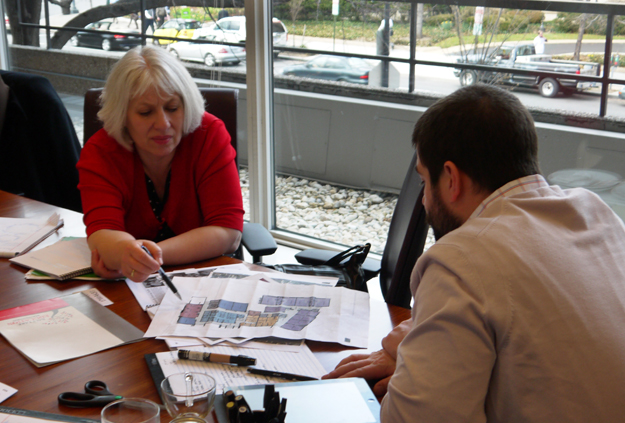Five public districts get useful advice through a workshop presented by the USGBC and American Architectural Foundation in Washington, D.C.
 |
| Photo courtesy AAF |
| Joanne R. Milner, the Education Partnership Coordinator and a senior advisor to Salt Lake City Mayor Ralph Becker, works with architect Ryan Freeland of Cuningham Group. |
In November 2010, ten city mayors and nine school superintendants met with sustainability experts, architects, and educators at a three-day summit in Sundance, Utah. The goal was to develop an action plan for greening American schools. Toward the end of the conference, Ronald Bogle, president and CEO of the American Architectural Foundation (AAF), committed to a future workshop that would continue the dialogue.
Bogle recently made good on that promise. From March 7 to 9, the AAF collaborated with the USGBC’s Center for Green Schools to host the National Green Schools Design Summit in Washington, D.C. This time the agenda examined real issues from five city school districts. “We wanted to take the lessons learned from Sundance and expand on them,” says Graham Stroh, AAF program manager. “There’s a lot of power in bringing these groups together.”
The participating cities were: Bismarck, North Dakota; Charleston, South Carolina; Philadelphia; Sacramento, California; and Salt Lake City. Charleston’s Mayor Joseph P. Riley, Jr., Sacramento’s Mayor Kevin Johnson, and Salt Lake City’s Mayor Ralph Becker had all been at Sundance and were grateful for the opportunity to attend the summit in D.C. “Being a part of this group as a follow-up to Sundance is a privilege,” said Mayor Becker.
On day one, the city contingents began by presenting one or two problematic case studies from their districts. City and school leaders were then grouped with architects for design charrettes to create tailor-made solutions for each project. On day two, each group presented their results during 15-minute presentations, which varied greatly—from broad overviews for district-wide sustainable strategies to specific design enhancements for school buildings.
Salt Lake City shared a plan for a community-learning center, to be built between a middle school and elementary school and combine three programs: adult learning; daycare; and a dental, vision, and mental health clinic. Though the project is currently out to bid, the team learned so much about sustainability and systematic thinking during the workshop that they may put it on hold to reconsider some of the design elements.
The Charleston group worked with the architects to revamp the layout of a planned learning center, breaking it into separate mixed-use structures that reflect the historic and local “freedman’s cottage” style. “We came with a complicated problem, and we solved it,” said Mayor Riley. Likewise, the Philadelphia team presented a strategic plan for one troublesome school that will transform an unseemly chain link fence into a public art project, create a sunflower field in a vacant lot, and help form partnerships with local businesses for school programs.
Tamara Uselman, the superintendant for Bismarck Public Schools, sees broader applications for the suggestions of her team’s architects: “What we learned is going to have a huge impact across the state.”
In closing, AAF Chairman G. Sandy Diehl posed a fundamental question: “How do we scale this great mission?” Responses ranged from rebranding green schools as healthy or livable learning environments to presenting better metrics about the health benefits and the ROI for green schools. Others pointed out the need to collaborate with the city to fight the political battles necessary to garner funding.
Ultimately, Sacramento Mayor Johnson, along with the chief of staff for his city’s school district, Teresa Cummings, hopes to use the architects’ recommendations as a checklist for future projects. “The city and school district are a natural alliance,” says Johnson. “We can help each other.”

Post a comment to this article
Report Abusive Comment